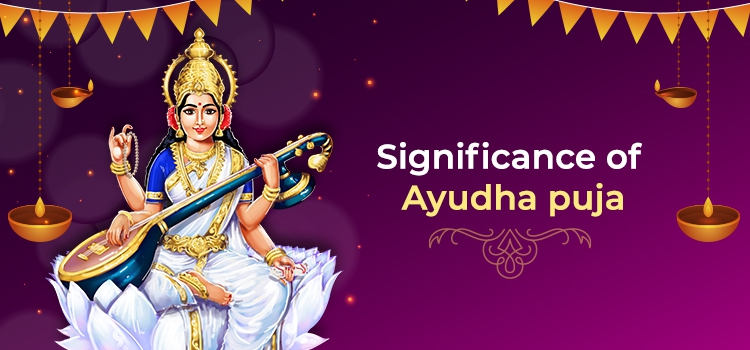Significance of Ayudha Pooja
We use several tools and implements in our daily life as part of our work. They help us make a living and fulfill our needs. On the day of Ayudha Puja, Hindus honor such tools and express their gratitude to them. It can include small things like knives, pins, scissors, and spanners, as well as large instruments like cars, computers, buses, and machinery. Ayudha Pooja acknowledges and honors the utility of things in our life.
In the ancient days, it was the custom to worship weapons used in war. In Karnataka, Ayudha Puja celebrations commemorate the killing of the demon, Mahishasura, by Goddess Chamundeshwari, an avatar of Goddess Parvati.

Ayudha Pooja is part of the Navratri festival, which takes place in September-October. During Navratri, Hindus worship 9 forms of Goddess Durga, who incarnated to kill Mahishasura. The gods could not defeat him. so they merged their powers and created Durga. The Gods also gave her many divine weapons to fight the demon, as well.
Ayudha Pooja 2022
In 2022, Ayudha Pooja is on October 4, i.e., the ninth day of Navratri.
Ayudha Pooja Observances
On this day, Hindus clean and worship all their tools and instruments. Vehicles are also cleaned thoroughly. Those which are small and medium-sized are kept on a pedestal and decorated with flowers. Vermilion is applied to them as well. People put garlands, plantain stems, and leaves on their cars and apply sandal paste and vermilion on them. Fresh flowers are kept before the deities in the Pooja room. They also hang mango leaf thorans at the entrance of the house. Books, laptops, writing instruments, etc., are also kept along with the tools before the deities, where they remain untouched for a day.
Puffed rice or poha, mixed with jaggery, Panchamritam, and sundal, are the main offerings. Fruits, flowers, and white pumpkins are also offered. People also chant Ayudha Pooja Mantras on the occasion.
After the Pooja, people use the tools as the Gods have blessed them. They show Aarti to vehicles with camphor kept on a lemon, pumpkin, and coconut, which are then smashed open on the ground. Then they take their vehicles for a short drive.
Legends behind Ayudha Pooja
1.In the Mahabharata epic, after the Pandavas went into exile, Arjuna hid his weapons in the hollow of a tree. When the exile ended after 14 years, they returned to Hastinapur on Vijayadashami day. On the same day, Arjuna also retrieved his weapons.
2.In the ancient days, there was a custom called Kala Bali, or Sacrifice to the battlefield. Both sides in a war would sacrifice a human to appease the war gods. Later, they began to sacrifice cattle or sheep. In the Mahabharata, an astrologer advised Duryodhana to make the sacrifice on Amavasya (new moon) the day before the war began. Arjuna’s son, Aravaan, offered to be the sacrifice. But Krishna convinced him to be the sacrifice for both the Kauravas and the Pandavas. Yudhishtira then sacrificed him to Goddess Kali, who manifested on the battlefield and blessed the Pandavas to achieve victory. The sacrifice was on the day following Dussehra, which Hindus celebrate as Ayudha Pooja
3.After killing Mahishasura, Goddess Durga laid down her divine weapons, which people and the Gods worshipped. This day is Ayudha Pooja.
Goddesses associated with Ayudha Pooja
Saraswati (Goddess of Wisdom), Parvati( the Divine Mother), and Lakshmi (Goddess of Wealth) are given importance on Ayudha Pooja day.
Ayudha Pooja in Karnataka
As per legend, Ayudha Pooja was performed on the day before Goddess Chamundeshwari’s war on Mahishasura. All her weapons were worshipped before the war. Vijayadashami, the day that follows, celebrates her victory. In Karnataka, all the weapons in the Mysore palace are worshipped on the day of Navami in the courtyard by the Maharaja. Transport vehicles, cows, and horses are also worshipped. This indicates that chariots that were being driven to the battlefield were also prayed to.
Ayudha Pooja is called Astra Pooja in Odisha and Mahanavami in eastern and northern India.
Significance of Ayudha Pooja
Work is worship. Doing our best at work is also a kind of offering to God. Work sustains us and provides us and our family with food, clothes, and shelter. Hence, we worship our tools and implements on this day to invoke divine blessings to do our work well so that we can progress and prosper in life.
In ancient India, kings used to worship deities of war and their weapons and were inspired by them. But these stories also have allegorical and spiritual meanings. The battle between the Gods and demons is also an internal one. Mahishasura’s death symbolizes the destruction of tamasic qualities within us.
Soon after he received the spear from Goddess Parvati, Muruga comes to personify the highest Advaitic truths and even teaches the meaning of “Om” to Lord Shiva himself. Hence, he is worshipped as Swaminatha - the “Swami” who taught the “Natha” or Lord Shiva.
Hinduism ascribes divinity to all of creation. God is both immanent and transcendent. This approach infuses all activities of life with divinity. Work becomes worship, and this philosophy of karma yoga provides another context for the worship of weapons. Ayudha means ‘weapons,’ but it can also mean "instrument or implement."
On the 9th day of the Navaratri festival, people clean, decorate and worship the tools or implements that help them to make a living. They feel a manifestation of the divine in them. Apart from soldiers and their weapons, this also applies to musicians and musical instruments, farmers and the plow, students and their books, and workmen and machinery.
According to Hinduism, Dharma, Artha, Kama, and Moksha constitute the 4 great “purusharthas” or goals of life. Dharmic conduct forms the basis for attaining all the other goals. The soldier’s Dharma is to fight when needed. A king must also enforce Dharma and protect society. Thus, the use of weapons is part of a sacred duty to safeguard Dharma.



















